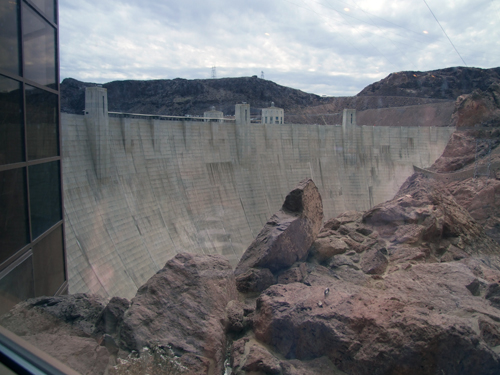
-Eighth in a series–
By Donald H. Harrison

BOULDER CITY, Nevada – Whereas the watchword of this publication is “There’s a Jewish Story Everywhere,” at the Hoover Dam, apparently, the motto is slightly different: “There’s a Statistic Everywhere.” Or so one might believe watching an introductory video and taking a math-laden tour of the hydroelectric facility that was completed in 1935 and was boasted of then as the greatest engineering project since the Pyramids in Egypt.
The dam, which straddles the Nevada-Arizona border, is located a short ride east of the Interstate 15 on Nevada State Route 146.
Oh the Kabbalists who love gematria would have a field day at the Hoover Dam, which is 726 feet tall and has caused the Colorado River to back up behind it, creating the 156,000 acre Lake Mead, which it is reported is wet enough to cover the entire state of Pennsylvania with a foot high of water.
To build the dam, the Colorado River had to be diverted from its course that follows an earthquake fault line where shakes of 5.2 have been recorded, but never anything close to a magnitude of 8.6, which the Hoover Dam was built to withstand.
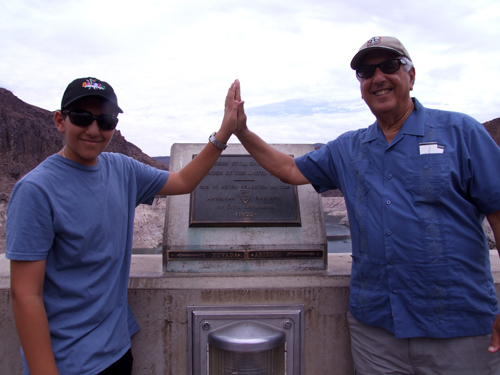
Over a period of 19 months, engineers cut four 4,000 foot long, 56-foot diameter diversion tunnels through the canyon walls on either side of the river. They also built two temporary coffer dams to force the water into the tunnels on courses that emptied down river. The upper coffer dam was 100 feet tall, the lower coffer dam was 65 feet tall, and once the water was diverted, crews still had to dig through 135 meters of silt, mud and gravel to reach bedrock.
Think of a pipe 56 feet in diameter. Try to imagine how wide a truck would have to be to carry it down the highway, or how wide a train would need to be to get it down the track. You don’t have to be a statistician or an engineer to know that such pipe sections are just too big to be transported, so the engineers had to build a factory in the desert to manufacture these and other components of the dam.
Once the spot was drained, the real work got started. Every 78 seconds, 16 tons of concrete was poured into wooden forms that became the building blocks of the dam. Small one inch pipes were inserted into these forms to carry water for cooling purposes. Had this method not been devised, according to the statisticians it might have taken the 3 million cubic yards of concrete poured at the site more than 100 years to cool!
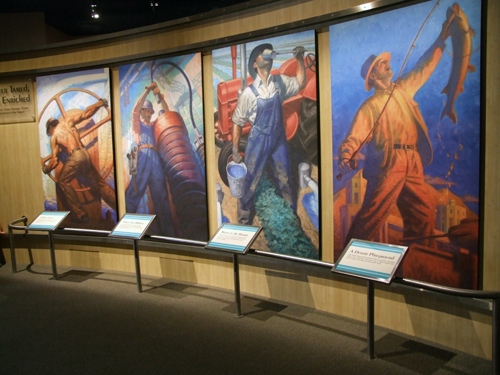
An average of 3,500 workers per day, working three 8-hour shifts, seven days a week, 363 days a year (there were two days off) were paid $4 per day (a good wage back in the days of the Great Depression). In five years, which was two years ahead of schedule, they laid down 5 million barrels of structural cement, 18 million pounds of structural steel, 21 million pounds of gates and valves, and 840 miles of pipe. Those statisticians say if you took all the concrete poured for the dam and adjoining structures, you’d have enough to build a four-foot-wide sidewalk all the way around the world at the equator.
Located seven feet below the rim of the dam are two spillways, one on the Nevada side and one on the Arizona side. They have been employed only twice. The first time was in 1941 for testing purposes; the second time was for 62 days in 1983 when there was unusually heavy snowfall in the Colorado Rockies. The daily volume of water coursing down the spillways was said to be equivalent to the daily flow of Niagara Falls.
Water also is taken from Lake Mead into four 395-foot tall intake towers (two on the Nevada side, two on the Arizona side) and transported into 30-foot diameter pipes, at a rate of 296,000 gallons per second. According to the tour guide, that’s enough water to fill up an Olympic size swimming pool in about 5.6 seconds. From there, the water increases its velocity as it is forced into smaller and smaller pennstock pipes. Thirteen-foot diameter pipes rotate magnetized spinners, turning the turbines that power the electricity-producing generators. From there the water continues its journey back to the Colorado River.
On the tour, one can look down to a subterranean structure to see the tops of some of those 70 foot high generators, 40 feet of which are buried under the floor. There are 17 such generators in all, each producing up to 130 megawatts of power, enough for each to electrify a city of 65,000 homes.
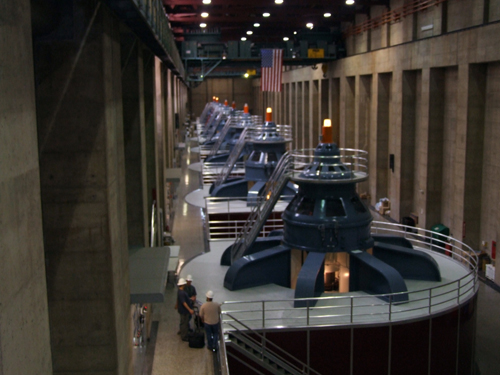
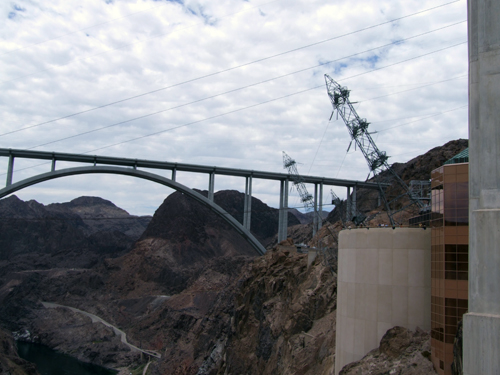
Flood control, rather than electricity generation, is the main purpose of the Hoover Dam, which was named after former President Herbert Hoover in 1947. Originally the structure was named the Boulder Dam, but it was decided to recognize the former U.S. President because back in his days as Secretary of Commerce he helped to negotiate a compact among seven states utilizing Colorado River water that enabled the dam to be built and the river waters to be apportioned.
So that’s an example of a “statistical story everywhere” – at least in the vicinity of the Hoover Dam – but where is the Jewish story in all this?
The architect of the dam was Gordon Bernie Kaufmann, whose father was of Jewish origin and whose mother’s maiden name was Isaacs. In that Kaufmann is buried under the sign of a cross at Golden State National Cemetery, we can’t claim Kaufmann as a Jew, but clearly his family was no stranger to the religion.
Kaufmann designed both residential and commercial projects, including the Doheny mansion in Los Angeles, the Los Angeles Times building, the Santa Anita Race Track, and the Athenaeum at Caltech.
One of the reasons Kaufmann’s story resonated with me was because my own paternal grandfather was a far lesser known architect, whose practice was mainly confined to New York and Connecticut. He grew up with the name Meyer J. Harowitz, but after he started practice, he changed his name to M. Joseph Harrison, a year before my father was born. Why? Because at that time in the United States, architects with Jewish sounding names often were passed over for commissions regardless of their qualifications.
By changing his name, he was able to compete for some nice projects in those two states. My father was born in 1910 as Martin B. Harrison, and, as a result, my surname also is Harrison. One of grandpa’s sisters, wishing to avoid discrimination, converted to Catholicism, and avoided her Jewish family thereafter. I have no way of knowing, but I couldn’t help but wonder if anyone in the Kaufmann/ Isaacs family had similar experiences.
And given that the name “Kaufmann” obviously did not prevent him from getting architectural commissions, I wonder if my own family’s name change more than a century ago was really necessary.
*
Harrison is editor of San Diego Jewish World. He may be contacted via donald.harrison@sdjewishworld.com